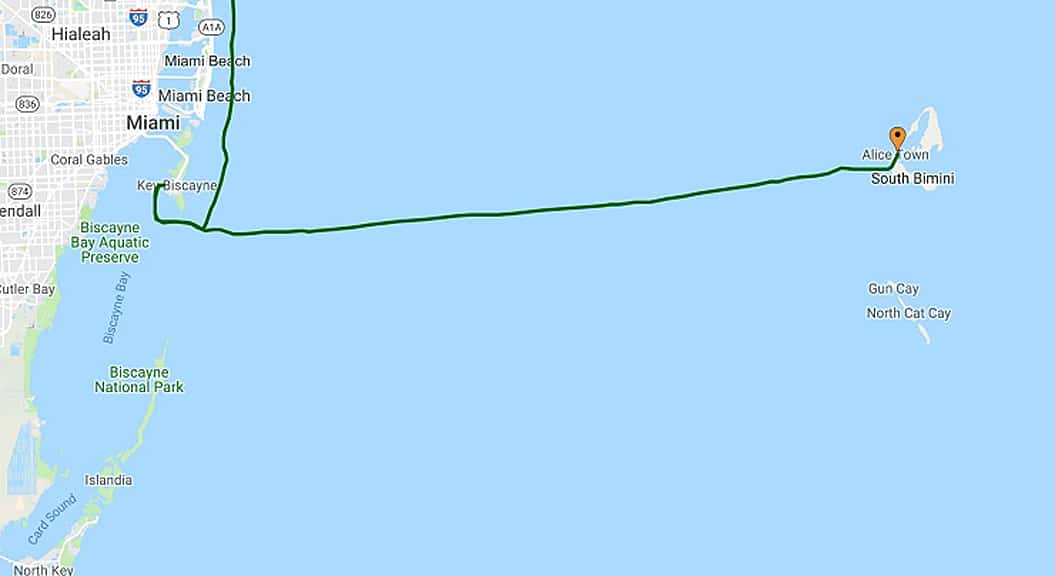Tommy woke us at 5:40 a.m. before our alarm clock. We were both excited and nervous about our crossing. On the Chesapeake Bay and ICW, we don’t usually wear life jackets in calm weather, but we wear them on any ocean passage. For this crossing we also had tethers at hand. A tether clips to the metal rings on the life jacket and to a secure part of the boat for safety. Tommy also set up a jackline to run from bow to stern on the port side. This is a line that you can clip your tether to. It will allow your tether to slide along so you can walk to the bow if needed, yet still be secured to the boat.
None of this was essential today, as the sea was quite calm with only small waves and some long period swells. The light ESE wind was too much on the nose to set the jib, but we were able to motor sail using the mainsail which helped a lot with speed and stability.
It was strange to see Miami disappear behind us and have only water and a few distant pleasure boats and freighters in view. We steered by the compass and our route line on the Chartplotter (called a rumb line) as Octavius, our auto-pilot, called in sick for today’s crossing, much to Tommy’s disgust.
In what seemed like not much time at all, we could see trees and shoreline on Bimini. We read and heard a lot of conflicting information about heavy shoaling (shallow areas due to a shifting bottom) in the entrance channel to North Bimini and were nervous. Once we got close, we heard some VHF traffic from several boats claiming the entrance markers were way out of position, particularly the red ones which you are supposed to pass on the right side. Luckily, there were three boats about two miles in front of us going in also. We timed our approach to be on a rising tide, but it was only 1 hour beyond low tide. We were able to look at the tracks of all three boats on our chart plotter using their AIS signatures. They all left the red entrance markers on the left by a wide margin then made a hard left only 300 feet from a stone jetty just beyond them. We followed their exact same path, keeping both red markers well on the left (so counter-intuitive). Amazingly, we never saw less than 10’ of water the whole way in. The dockmaster said the markers were blown off station by recent hurricanes and have yet to be repositioned.
As we made the turn into the channel, a dozen small flying fish leapt from the waves and paralleled C Ghost for some yards before dropping back into the sea. Ahead, 3-foot rays leapt straight out of the water like startled cats.
Looking down, I could see grass, fish, an abandoned length of pipe and white sand. Next, we found ourselves in a narrow channel packed with boats, people, and sounds. It felt like a nautical rush hour. Boats with deeper drafts picked their way along, while shallow draft roundabouts buzzed by and around pokier vessels like ours. At our destination, The Big Game Marina, there was a back-up of large boats waiting to dock. We were given an assignment the north side of C dock – slip C14. Once deep into the C fairway, a marina staffer realized that C14 was occupied, and called to us to “turn around” and go to the north side of D dock. As the C fairway was quite narrow, this required that Tommy execute a very tight and controlled turn (bow-thruster assisted) right in front of a 44′ Leopard catamaran that was waiting to enter C fairway. Paula stood on the bow giving distance info to Tommy and ready to fend off, but no assistance was needed as the turn went smoothly. Paula DID experience a sudden drenching fear sweat as the only minor complication. We docked safely in D11 and looked at each other in amazement. We can’t believe we are here!


2 Responses
That’s sailing for you but you arrived intact!
How very exciting, thanks for sharing.